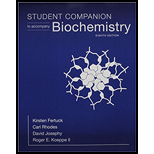
Concept explainers
(a)
Interpretation:
The most suitable matching pair of answers should be selected.
Concept introduction:
Photosynthesis is the process by which plants store energy of sunlight as chemical energy. Process happens in the chloroplast of a plant cell. Photosynthesis happens in two main stages - light reaction and dark reaction.
Answer to Problem 19P
- a) Calvin cycle − the dark reactions
Explanation of Solution
Photosynthesis happens via two main stages as light reaction and dark reaction. Light reaction happens in the presence of sunlight. Two photosystems called PS I and PS II absorbs energy of sun light. At the end of light reaction ATP, NADPH and O2 produce. Next, the dark reaction (which is also known as Calvin cycle) starts which uses ATP and NADPH.
For the dark reaction there is no need of sunlight which happens within the stroma. This is a series of

Figure 1: Calvin cycle
(b)
Interpretation:
The most suitable matching pair of answers should be selected.
Concept introduction:
Photosynthesis is the process by which plants store energy of sunlight as chemical energy. Process happens in the chloroplast of a plant cell. Photosynthesis happens in two main stages - light reaction and dark reaction.
Answer to Problem 19P
- b) Rubisco − catalyzes CO2 fixation
Explanation of Solution
Rubisco (Ribulose-1,5-bisphosphate carboxylase/oxygenase), is an enzyme used in the dark reaction of photosynthesis. It catalyzes the carbon fixation process where atmospheric carbon dioxide is converted to glucose by photosynthetic organisms..
The enzyme is capable of fixing both CO2 and O2. This enzyme is comparatively less efficient at low CO2 concentrations and tends to bind O2. This series of reactions start with O2 to finally produce CO2. The process is known as photorespiration.
(c)
Interpretation:
The most suitable matching pair of answers should be selected.
Concept introduction:
Rubisco activase enzyme is important in activating Rubisco. Rubisco (ribulose-1,5-bisphosphate carboxylase/oxygenase), is an enzyme used in the dark reaction of photosynthesis. It catalyzes the carbon fixation process where atmospheric carbon dioxide is converted to glucose.
Answer to Problem 19P
- c) Carbamate − required for the rubisco activity
Explanation of Solution
In plants and some types of green algae, an enzyme called RuBisCO activase is present. This is required to allow the rapid formation of carbamate in the active site of rubisco. RuBisCO activase is required because the ribulose 1,5-bisphosphate (RUBP) substrate binds more strongly to the active sites lacking carbamate and hence slows down the activation process.
(d)
Interpretation:
The most suitable matching pair of answers should be selected.
Concept introduction:
Starch is a
Answer to Problem 19P
- d) Starch − storage form of carbohydrates
Explanation of Solution
Starch is a polymeric carbohydrate produced by joining a large number of glucose units via glycosidic bonds.
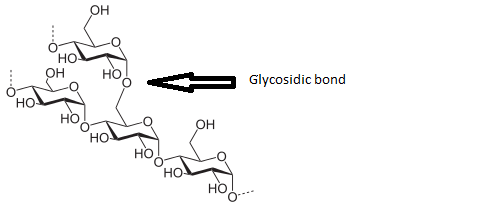
Figure 2: Structure of starch
After plants produce glucose by photosynthesis, it is stored in the cells as starch. Starch is insoluble in plant cell. So, unlike starch glucose increases the concentration of the plant cell.
(e)
Interpretation:
The most suitable matching pair of answers should be selected.
Concept introduction:
Sucrose is a disaccharide of Glucose and fructose, having twelve carbon atoms. Disaccharide consists of two monosaccharides, having six carbon atoms each.
Answer to Problem 19P
- a) Sucrose − transport form of carbohydrates
Explanation of Solution
Sucrose consists of a glucose molecule and a fructose molecule joined through a glycosidic bond.
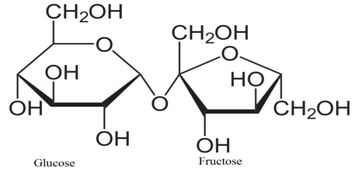
Figure 3: Structure of Sucrose
Plants store glucose (produced in photosynthesis) as starch in different places such as in fruits, seeds, and roots. Starch is insoluble in water and cannot be transported. When the plant needs energy, starch is converted to sucrose and transported. Even though glucose is soluble in water, plant does not convert starch to glucose. Since glucose is highly reactive compared to sucrose, it can transform into other intermediate compounds during transportation. Once it reaches the destination, sucrose is converted to glucose.
(f)
Interpretation:
The most suitable matching pair of answers should be selected.
Concept introduction:
Amylose is a polysaccharide made up of glucose units. These glucose molecules are bonded to each other through a (1→4) glycosidic bonds. Due to its tightly packed helical structure, amylose is resistant to digestive enzymes and therefore known as a resistant starch.
Answer to Problem 19P
- b) Amylose -
Explanation of Solution
As indicated in the figure, the first and fourth carbon of the glucose monomers react to form a bond between them. This bond is known as 1, 4 glycosidic bond.

Figure 4: Structure of amylose
(g)
Interpretation:
The most suitable matching pair of answers should be selected.
Concept introduction:
Amylopectin is a highly branched
Answer to Problem 19P
- c) Amylopectin − includes
Explanation of Solution
Amylopectin is a highly branched polymer. This is also known as polysaccharide. The primary unit is glucose. Like amylose, the glucose units are linked in a linear way with a (11→4) glycosidic bonds. This

Figure 5: Structure of amylopectin
(h)
Interpretation:
The most suitable matching pair of answers should be selected.
Concept introduction:
Photosynthesis is the process by which plants store energy of sunlight as chemical energy. Process happens in the chloroplast of a plant cell. Photosynthesis happens in two main stages - light reaction and dark reaction. The dark reaction consists either of the two
Answer to Problem 19P
- d) C3 plants − 3 − Phosphoglycerate is formed after carbon fixation
Explanation of Solution
The dark reaction of photosynthesis consists of two metabolic pathways, that is, C3 and C4 cycle. All the green plant uses one of these two pathways. The nomenclature is based on the number of carbon atoms present in the first metabolite produced after CO2 fixation.
The first metabolite produced in C3 cycle composed of three carbons while a four carbon metabolite is produced in C4 cycle.
The light reaction is common to both C3 and C4 cycle. But the type of enzymes and intermediate produced during the dark reaction are different.
RUBP (Ribulose Bisphosphate) carboxylase is the enzyme of C3 cycle which fixes CO2, present in the atmosphere. After Co2 fixation, a five-carbon molecule, RUBP (Ribulose bisphosphate) reacts with CO2 to form a six-carbon complex. The six-carbon molecule break immediately and form two 3- phosphoglycerate. 3- phosphoglycerate consists of three carbon atoms.
So, this is the first stable product of CO2 fixation. This is the reason why the mechanism is known as C3 cycle.
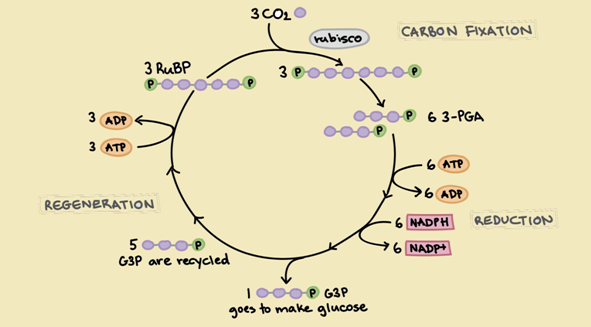
Figure 6: Calvin cycle of C3photosynthesis representing the carbon fixation.
(i)
Interpretation:
The most suitable matching pair of answers should be selected.
Concept introduction:
Photosynthesis is the process by which plants store energy of sunlight as chemical energy. Process happens in the chloroplast of a plant cell. Photosynthesis happens in two main stages - light reaction and dark reaction. The dark reaction consists either of the two metabolic pathways, that is, C3 and C4 cycle.
Answer to Problem 19P
- e) C4 plants − carbon fixation results in oxaloacetate formation
Explanation of Solution
The dark reaction of photosynthesis consists of two metabolic pathways, that is, C3 and C4 cycle. All the green plant uses one of these two pathways. The nomenclature is based on the number of carbon atoms present in the first metabolite produced after CO2 fixation.
As explained earlier, the first metabolite produced in C3 cycle composed of three carbons while a four-carbon metabolite is produced in C4 cycle.
Out of the two steps of photosynthesis (light and dark reaction), light reaction is common. But the type of enzymes and intermediate produced during the dark reaction are different.
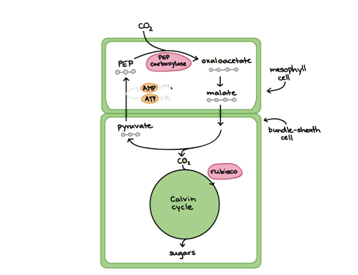
PEP (Phosphoenolpyruvate) carboxylase is the primary enzyme of C4 mechanism which catalyzes the fixation of CO2 in chloroplast. For this, a three-carbon molecule (PEP) reacts with CO2 to form a four-carbon molecule which is known as oxaloacetate. Oxaloacetate is the first stable product of C4 cycle.
This is the reason why the mechanism is called C4 mechanism. The reactions take place in mesophyll cells.
(j)
Interpretation:
The most suitable matching pair of answers should be selected.
Concept introduction:
Stomata are pores, found in the epidermis of leaves, stems, and other organs that facilitate gaseous exchange.
Answer to Problem 19P
- f) Stomata − allow exchange of gases
Explanation of Solution
Stomata are the pores which are mostly found in the epidermis of leaves and stems. It facilitates gaseous exchange. This stomatal pore is bordered by the guard cells which regulates the stomatal opening and closing.
Atmospheric air consists of carbon dioxide and oxygen enters the plant through these openings. These gases are crucial for photosynthesis and respiration, respectively. Also, water vapor releases to the atmosphere through the stomata. The process is known as transpiration.
So, stomata are the structures, present in the plant leaves crucial for all types of gaseous exchanges.
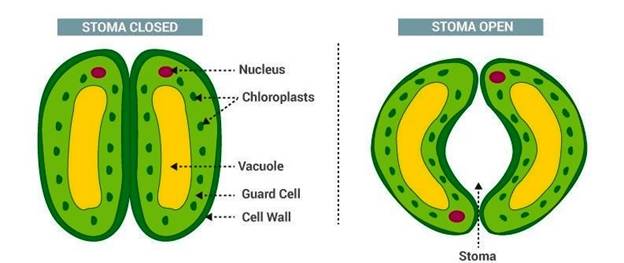
Figure 8: Microscopy view of stomata
Want to see more full solutions like this?
Chapter 20 Solutions
Student Companion for Biochemistry
- Need help Which of the following statements is most correct? Explain A. NAD/NADH are involved in catabolic reactions. B. In plants the major source of NADH is from ferredoxin formed from the high energy electrons generated by Photosystem II. C. Large molecules are built using catabolic reactions. D. NADP is not found in animal cells.arrow_forwardUnderstanding a Ubiquitous Series of Metabolic Reactions Study Figure 23.9. Where else in metabolism have you seen the chemical strategy and logic of the -oxidation pathway? Why is it that these two pathways are carrying out the same chemistry?arrow_forwardTrue or False? Electrons after complex III are then sent immediately to complex IV. (during ETC in cellular respiration)arrow_forward
- choose correct letter and explain why you choose it 1.Which of the following terms is closest to our current understanding of enzyme function? a. Fluid mosaic model b. Induced fit model c. Lock and key model d. Cofactor e. Free energy 2. If a hypothetical chloroplast has only photosystem I, then the Calvin cycle a. can proceed as normal b. cannot proceed because only NADPH is produced c. cannot proceed because only ATP is produced d. cannot proceed because it depends on light e. cannot proceed because O2 cannot be produced from carbon dioxidearrow_forwardTrue or False? In photosynthesis, both photosystems (I and II) depend on the energy of sunlight to excite a chlorophyll molecule until it releases an electron.arrow_forward20. A hoax, perhaps? The citric acid cycle is part of aero-bic respiration, but no O 2 is required for the cycle. Explainthis paradox.arrow_forward
- I'm confused about glycolysis and gluconeogenesis. Question: What is the function of glyceraldehyde 3-phosphate dehydrogenase? Is it because of -> The incorporation of a phosphate from ATP and reduction of glyceraldehyde 3-phosphate or ->The incorporation of phosphate from inorganic phosphate and reduction of glyceraldehyde 3-phosphate. or -> The incorporation of phosphate from inorganic phosphate and oxidation of glyceraldehyde 3-phosphatearrow_forwardRelating to bioenergetics: a. The equilibrium constant for a particular reaction is 6.8 x 10-5 which makes this reaction exergonic. True or False?b. All processes that occur in the universe are spontaneous and have low enough activation energies that molecules can often overcome the energy barrier. True or False?c. ATP has a highly negative free energy change in part because the negative charges on the oxygens repel each other in ATP but less so in ADP. True or False?arrow_forwardPlease don't copy Complete the Calvin-Benson cycle if 12 CO2 molecules are fixed. Indicate the number of starting products, intermediates and final products. Count your carbons at each step. How many glucose molecules can be made?arrow_forward
- ATP synthase: Select one: a. is an enzyme that is a tiny rotary motor. b. performs a similar function in cellular respiration and photosynthesis, but is of very different structure and biochemical composition in the different processes. c. is used to generate ATP in cellular respiration, but hydrolyzes ATP to perform active transport in photosynthesis. d. is a component of the electron transport chain.arrow_forwardSmall explanation please. what is a product in the first stage of the Q- cycle? a. two electrons b. Q- cation c. cyt c (oxidized) d. two more protons in the matrix e. Q- radical anionarrow_forward1- ATP consider as an important molecule in metabolism, because : A) It is one of the four building blocks for DNA synthesis.B) It provides energy coupling between exergonic and endergonic reactions.C) Its terminal phosphate group contains a strong covalent bond that, when hydrolyzed, releases free energy.D) Its hydrolysis provides an input of free energy for exergonic reactions.E) Its terminal phosphate bond has higher energy than the other two. 2- How many ATP yield from complete oxidation of glucose to carbon dioxide and water: A) 38 B) 32C) 2D) 8E)24arrow_forward
 BiochemistryBiochemistryISBN:9781305577206Author:Reginald H. Garrett, Charles M. GrishamPublisher:Cengage Learning
BiochemistryBiochemistryISBN:9781305577206Author:Reginald H. Garrett, Charles M. GrishamPublisher:Cengage Learning Biology (MindTap Course List)BiologyISBN:9781337392938Author:Eldra Solomon, Charles Martin, Diana W. Martin, Linda R. BergPublisher:Cengage Learning
Biology (MindTap Course List)BiologyISBN:9781337392938Author:Eldra Solomon, Charles Martin, Diana W. Martin, Linda R. BergPublisher:Cengage Learning

